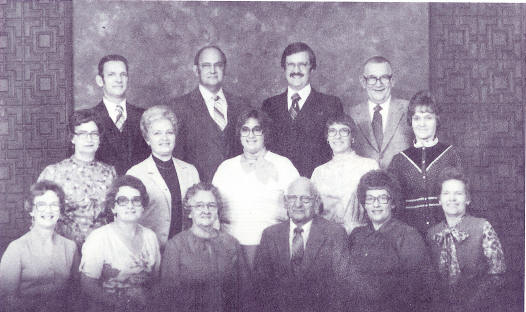BOONE, WILLIAM H. AND CARRIE (VERSTEEG)
William H. Boone (born in 1900) was the son of Henry and Dora (Klienhesselink) Boone. Henry came to America trom Gelderman, Holland at the age of 18 years. He came across alone and met his wife here. They had 9 children.
Carrie (Ver Steeg) Boone was the oldest child (born in 1902) of John A. and Anna (Vischer) Ver Steeg. Herfamily consisted of 13 children. John was an ice man, farmer, assessor, and drove the oil truck for Cambier. His father was a flag bearer in the Civil War and had a bullet hole through bis cap, but received only a slight scalp wound.
William H. attended school through the 7th grade and then helped his dad on the farm. Carrie attended school through the 8th grade and then stayed home to help the family. She can remember her job was to polish the kitchen stove, clean and fill the kerosene lamps, and pick up wood and cabs for the cook stove, besides caring for the younger children in the family.
They were married in 1921, at the home of William's parents in O.C. A chivalry by friends was done on the first evening, and food was demanded, which was the custom of that day. After the reception, a new car of one of the guests caught fire and burned completely, due to lack of water.
William was a butter maker for 4 years in O.C. and then moved to Sanborn, where they farmed. There were dust storms and midmorning they would have to leave the fields, due to poor visibility. The dirt piled in huge drifts. Naturally, the crops were poor.

Family of Mr. and Mrs. William H. Boone. Taken on their 60th
wedding anniversary, March 9,
1981.
In 1930 they moved to Sioux Center, where William worked with the Brommers in the livestock and grain business, and then became a trucker. He also leased the Skelly station, which was located at the present location of Ver Hoefs garage. In 1950 he became a hog buyer for Farmer's Coop Society and after retirement in 1966, he was caretaker of Central Park.
In 1941 the family was ill with scarlet fever. They were quarantined for 4 months. No one could leave or enter the house, although finally neighbors were allowed to come in and help with the care of the sick children. Ten pounds bags, filled with oats, were heated in the oven and placed on the sick ones, so the rash would break out sooner. William went to work, but had to sleep in the basement with borrowed bedding. There were no antibiotica, so complications set in and Kenneth died at the age of 4 years. Rev. Meengs had a short graveside service, but the family had to stay in the car, due to the quarantine. The house had to be fumigated, washed, and scrubbed after the quarantine was lifted.
The Mack truck was used for many purposes, other than livestock. It was scrubbed very clean and used to transport school students to picnics and music festivals. It was used for a family vacation to Michigan in 1947. Mattresses were placed on the deck for beds, a canvas top as a roof, rocking chair to quiet the children and lots of space for the children to play. Today, it would be called camping.
William and Carrie were blessed with 14 children. They are: William D. (deceased in 1981); Annabel (Mrs. James Cochran of Kalamazoo, Mich.); June (Mrs. Ted VandenBerg of S.C.); Joan (Mrs. Paul Den Hertog of O.C.); Carolyn (Mrs. Raymond Sneller of Parker,.So, Dak.); Lillian (Mrs. Norman Hogan of Lakewood, Calif.); Vernon of S.C.; Marvin of S.C; Kenneth (deceased in 1941); Audrey (Mrs, EImer Gesink of O.C.); Karen (Mrs. Irvin De Boer of S.C.); Judith (Mrs. Ivan Friese of Parker, So. Dak.); Ruth (Mrs. Gilbert Meyer of S.C.); and Raymond of Jacksonville, Texas.
William and Carrie were married 66 years, William died in 1987, due to heart problems and emphysema. Carrie lives in Sioux Center at 45-6th St. N.W., which is their original home, although it bas been remodeled and enlarged through the years. Maple trees which were planted in 1930 still adorn the roadside.
by Karen De Boer